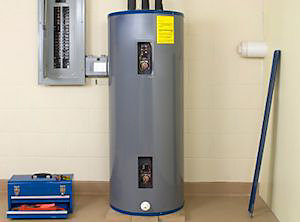Your Water Heater Is Leaking—What Should You Do?

There’s water around the water heater and you think it’s leaking. What should you do?
Does that sound like you? If so, you’re in the right place.
Here’s a step-by-step process of what to do:
Step 1: Determine if the water heater is actually leaking
Go to step 2 if you’ve already identified a definite leak source. If you have not, read this section.
Is there just a little water around the water heater? Does the water show up infrequently?
Good news: Your water heater may not have a leak. The water pooling around the water heater could be from condensation.
Condensation on a water heater usually forms in winter and early-spring months when water is coolest. When cool water enters the tank, it causes the surrounding air’s water vapor to shrink, turning the gas into a liquid.
It’s just like when water droplets (condensation) form on a glass of ice cold water on a humid day.
Clean up the water and lay some paper towels where you found the water pooling. Observe the water heater and its plumbing fixtures to see any signs of leaks.
Here are 4 places to look (use this hot water heater diagram to help guide your search):
1) Cold water inlet and hot water outlet connections (they could be loose)

2) Temperature and pressure relief valve

3) Heater drain valve

4) Bottom of water heater tank
If you don’t see any signs of a leak around these areas or if the problem goes away, it was probably just condensation.
If you find a leak or water keeps consistently pooling around the water heater, go to step 2.
Step 2: Turn off power to the water heater
If you have an electric water heater, find the water heater’s circuit breaker and flip it to “off.”

If you have a gas water heater, look on the water heater for an on/off switch or dial on that will let you turn it to “off.”
Step 3: Turn the cold water shut-off valve
Look at the top of the water heater. You should see a handle or a small dial. This is the valve to stop cold water from entering the tank.

Either pull the handle or turn the dial clockwise.
WARNING: Be careful not to make contact with the water heater tank in this step. A water heater’s temperature is often set at 140 degrees F.
Step 4: Call for help
Steps 1-3 help you minimize damage. Now it’s time to contact a plumber. Let them know where the leak is located.
Need your water heater leak repaired and live in the Atlanta area? Coolray’s Mr. Plumber can help.
Mr. Plumber has been serving the plumbing needs of homeowners in the greater Atlanta metro area since 1966.
Related Reading
Subscribe To Our Newsletter
Get up-to-date current news, promotions, and industry tips.
